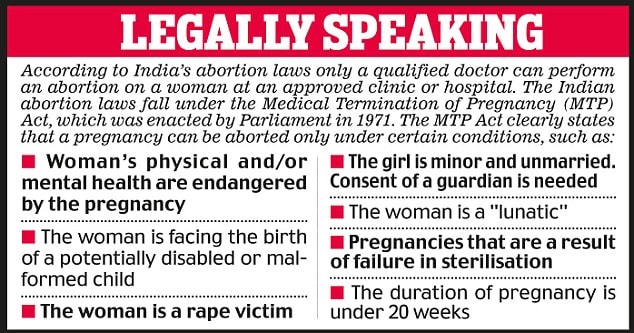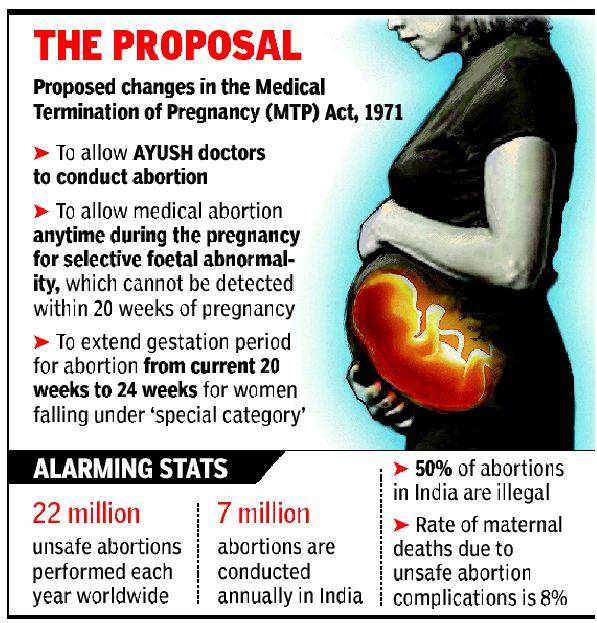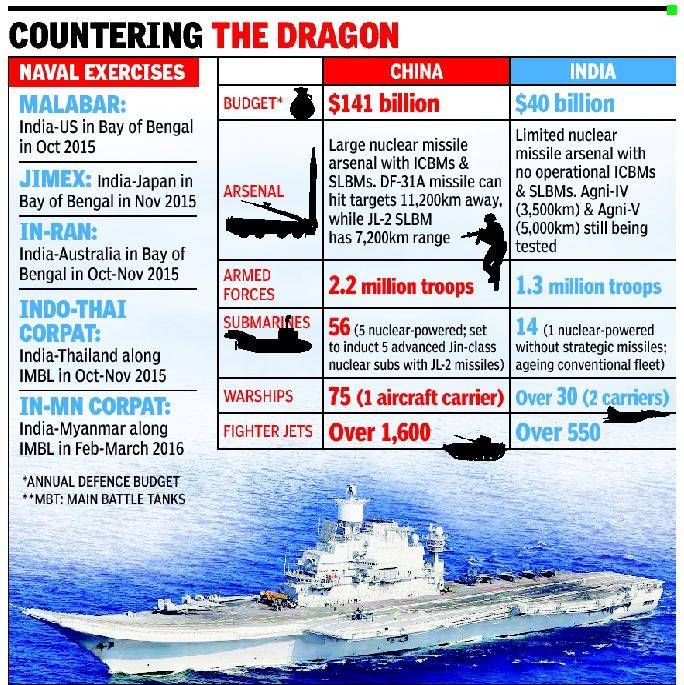IASbaba's Daily Current Affairs Analysis, IASbaba's Daily Current Affairs August 2015, International, National, UPSC
Archives
IASbaba’s Daily Current Affairs- 8th August, 2015
NATIONAL
India’s Inverted Abortion Politics
- Abortion has been legal in India since 1971, when the Medical Termination of Pregnancy Act (MPT) allowed termination of pregnancy until only 20 weeks’ gestation.
- Except for when a woman’s life is at immediate risk, the act restricts the termination of pregnancy after 20 weeks’ gestation, without explanation for this arbitrary cut-off.
- Though many sees the law as quite liberal, as it aims to reduce illegal abortion, questions being raised about women’s health.

What is Medical Termination of Pregnancy Act (MPT)?
- In India, Shantilal Shah Committee (1964) recommended liberalization of abortion law in 1966 to reduce maternal morbidity and mortality associated with illegal abortion.
- Medical Termination Of Pregnancy Act, 1971 (MTP Act) was implemented from Apr.1972.
- Pregnancies not exceeding 12 weeks may be terminated based on a single opinion formed in good faith.
- In case of pregnancies exceeding 12 weeks but less than 20 weeks, termination needs opinion of two doctors.
- The Medical Termination of Pregnancy (MTP) Act of India clearly states the conditions under which a pregnancy can be ended or aborted, the persons who are qualified to conduct the abortion and the place of implementation
If the pregnant women finds it necessary to terminate her pregnancy, does she have the right and upto what moment and on what conditions?
- Since such termination raises a conflict between the rights of the child and the mother (the child’s right to survival and the mother’s right to terminate the pregnancy), who is competent to adjudicate the claim?
- As a basic premise law states, that killing a foetus is not permissible. If then qualifies, this opposition by specifying a series of exceptions.
- These exceptions purpose to be based on some specific consideration. One such consideration is concerned with the conflict between the rights of the mother and the rights of the child.
- The mothers right is allowed to prevail, in some situations.
- The women’s supposed superiority in his matter is jurisprudentially explained in terms of the “necessity” of the situation coupled with her right to self-defence.
- To save the life or the health of the women, on a balance of probabilities, the lesser evil is looked upon as the limitation of the foetus to that of the mother.
What is The Indian Law on Abortion says?
- Section 312 of the Indian Penal Code, defines the offence of ‘causing miscarriage’ as follows “whoever voluntarily causes a woman with child to miscarry shall, if such miscarriage be not caused in good faith for the purpose of saving the life of the woman, be punished with imprisonment of either description for a term which may extend to 3 years, or with fine, or with both; and, if the woman be quick with child, shall be punished with imprisonment of either description for a term which may extend to 7 years, and shall also be liable to fine.
Is India’s abortion law putting women at risk?
- India’s abortion law are “contradictory” and need “urgent redrafting” to prevent women from making ill informed decisions and risking their lives with illegal terminations.
- If a serious fetal abnormality is detected after 20 weeks, the woman has no choice but to continue the pregnancy, even if she does not wish to.
- This arbitrary 20 week cut-off compels women to make ill informed decisions.
- If ultrasound testing, typically at about 18 weeks’ gestation in India, indicates a suspicious variation in fetal anatomy, the physician needs to ascertain the degree of seriousness with additional prenatal diagnostic tests.
- By the time a definitive diagnosis can be made, and the woman understands the prognosis, the pregnancy might well have advanced beyond 20 weeks.
What are the proposed amendments to solve this problem?

Is abortion justifiable in cases of rape?
- It is argued that in these tragic cases the great value of the mental health of a woman who becomes pregnant as a result of rape or incest can best be safe-guarded by abortion.
- It is also said that a pregnancy caused by rape or incest is the result of a grave injustice and that the victim should not be obliged to carry the fetus to viability.
- This would keep reminding her for nine months of the violence committed against her and would just increase her mental anguish.
- It is reasoned that the value of the woman’s mental health is greater than the value of the fetus.
What are the concerns over the sex selective abortions?
- The concerns over sex selective abortions are valid, hence the inclusion of the 20 week clause, it should be noted that taking away the right of the individual for abortion is unethical, for it deprives the woman of control over her own body.
- The right to life in Article 21 of the Indian Constitution is considered paramount and it includes the individual’s right to live a life of dignity.
- One could focus on more stringent laws regarding use of medical technology for sex-selection, and the enforcement of such laws rather than denying access to abortion.
Important CASE STUDY
- It was in 2008, when the infamous case of Mumbai couple Niketa and Harsh Mehta, stirred a nationwide clamour for changes in India’s 44 year old Abortion Law.
- The Bombay High Court had refused permission to abort a 26-week foetus with a serious heart defect after rejecting Niketa’s plea to terminate the pregnancy in a case torn between trauma and ethical issues.
- Mehtas sought an amendment to the MTP Act so that pregnancy can be terminated even after 20 weeks if doctors believe that the child, if born, will have serious abnormalities, so as to render it handicapped.
- But a division bench of Justice R M S Khandeparkar and Amjad Sayed observed that they could not alter the provision.
- The law may have thought differently, but gynaecologists across the country supported the couple.
- ‘It is high time we all questioned the laws that go against human welfare at large,’ GeetaChaddha, a senior consultant at Apollo Hospital had said.
- Niketa had a miscarriage on 27th week of her pregnancy.
Connecting the Dots:
- How India’s Abortion Laws Actively Take Away Individual Choice from Rape Survivors?
- Why India’s abortion law needs an urgent update?
- What issues that are not addressed in the draft Medical Termination of Pregnancy (Amendment) Bill, 2014?
INTERNATIONAL
Asian geopolitics
- New configurations in Asian geopolitics are emerging thick and fast.
- June, 2015 saw a new trilateral involving India, Japan and Australia.
- Japan will also be a part of bilateral India-US annual naval exercises, the Malabar slated to be held over the next few months.

Why is the term INDO-PACIFIC gaining traction now?
- It is clear that the present NDA government wants to revamp the Indian economy by attracting more foreign investments.
- Since the majority of its trade relations are through the sea, resolving the present and future maritime threats by giving more attention to the Indo-Pacific construct is of prime importance.
- India has declined China’s offer to join the latter’s Road and Belt project, as there are fears that it might be a means to contain India.
- Modi’s visit to India’s neighbouring Indo-Pacific regional nations, prior to his visit to China, implies not only the strategic importance of the region for India, but also shows how India wants to counter possible Chinese threats China in the Indian Ocean Region
What roles are envisaged for India and China in Indo-Pacific Region?
- The Indo-Pacific has many critical sea lanes of communication (SLOC) that are crucial for China’s energy transportation.
- China has long been using its strategies to reach out and find a permanent position in the Indian Ocean Region because the area is viable for long-term infrastructure development to reduce transport dependency through the Straits of Malacca.
- The similarities between India and China are not only in their size and population but also in their national interests.
- Both of them have a large economic drive: China to maintain its global position and India to increase its import surplus.
- Maritime security is also an essential to both.
- These reasons have led to both the countries investing time, energy and capital in the Indo-Pacific region.
Are the Asia’s ODD-MAN (Australia& Japan) in?
- Australia and Japan have been anxious to become part of the action and capitalize on the Asian Century opportunity, and to that end it needs to cast off its odd-man-out status in Asian regionalism.
- While the Asia-Pacific Community never got off the ground, the continuedrise of China (and India) created the ever aching longing for US reassurance adesire that has now been encapsulated in the Indo-Pacific idea.
- Among otherthings, this regional design seems able to address Australia’s dual anxiety of being both an odd man out and an odd man in for it at once places Australia at the centre of the action and allows the addition of twopowerful democratic friends (the USA and India) to its hedging strategy onChina.
Is the Nexus among the countries in the Indo-pacific Region Healthy?
- India and Japan have an institutionalized trilateral strategic dialogue partnership with the US. Initiated in 2011, maintaining a balance of power in the Asian-Pacific as well as maritime security in the Indo-Pacific waters has become an important element of this dialogue.
- A similar dialogue exists between the US, Japan and Australia.
- And now a new trilateral involving India, Japan and Australia have joined these initiatives, which can potentially transform into a “quad” of democracies in the Indo-Pacific region.
- The roots of this potential partnership were laid in late 2004 when navies from the US, India, Japan and Australia collaborated in tsunami relief operations all across the Indian Ocean.
Connecting the Dots:
- Critically analyze the undergoing transformation in the Asia’s geopolitical space.
- Are rapidly evolving regional geopolitics is forcing Asia’s middle powers (India, Japan and Australia) to devise alternative strategies for balancing China?













